Hamburg is always a gain
when your event becomes a part of history
Before we get started and show you in written words what makes Hamburg such a diverse and exciting city, we would like to take you on a little tour of the metropolis. Join our American resident David Patrician on a little digital journey!
Are you already hooked on Hamburg? We are too! Every day anew and every day a little bit more! Come with us – we have prepared a few topics for you that will surely interest you and give you a closer look at our city.
© mediaserver.hamburg.de / Andreas Vallbracht
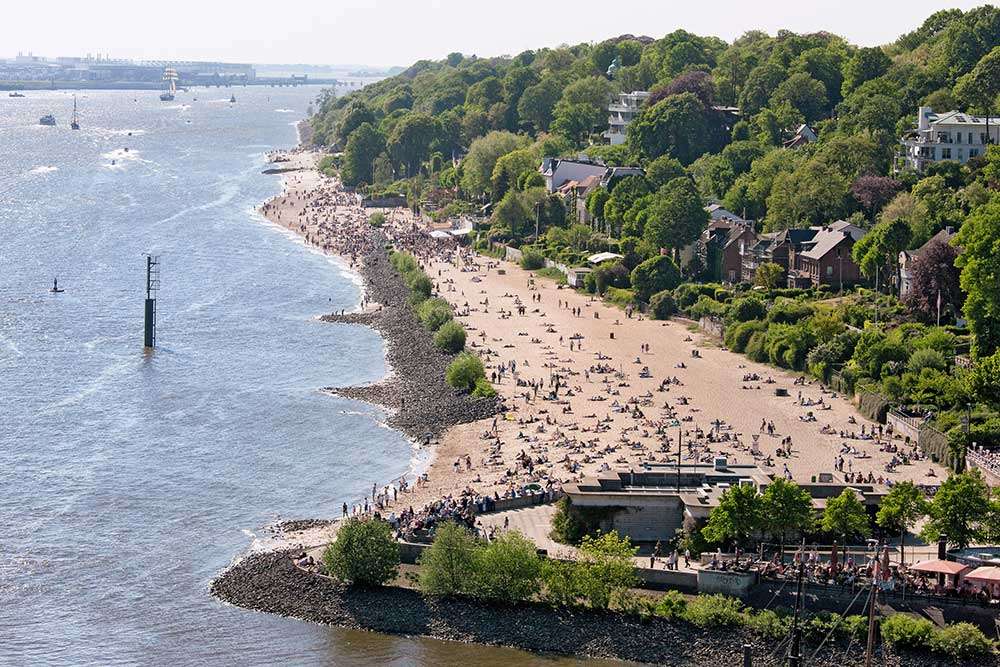
Hamburg on the map
Hamburg is a city by the water. Where there is really some serious water to be found in Germany is north! In the immediate vicinity, about an hour and a half drive from Hamburg, you can stand directly on the beach of the North Sea or Baltic Sea. And even within Hamburg, the element of water can be found almost everywhere! The city is crisscrossed by canals and rivers, mainly due to the lifeline of the city – the Elbe. In Hamburg, this creates an atmosphere that you can really say that everything is in the flow here.
Located in the north of Germany, the distances to other exciting cities are also very short. Copenhagen and Stockholm, for example, are within easy reach, and the capital Berlin is only about 1.5 hours away by train heading east.
Hamburg itself is also a city of short distances. Within the city center, you can reach many of the highlights by walking or by using the ideally developed public transport system. As a guest in Hamburg, you don’t really need a car. With the “S-Bahn”, the train ride from the airport only takes about 20 minutes, and in no time at all you will no longer find yourself in the arrivals hall of the airport, but standing with bare feet on the beach and enjoying the view of the river Elbe.
If we take the topic of accessibility a bit further, the question naturally arises: How do I actually get from the USA to Hamburg? To be honest, that is quickly told. From almost every major airport in the U.S., you can reach Hamburg with just one stopover.
© mediaserver.hamburg.de / Andreas Vallbracht
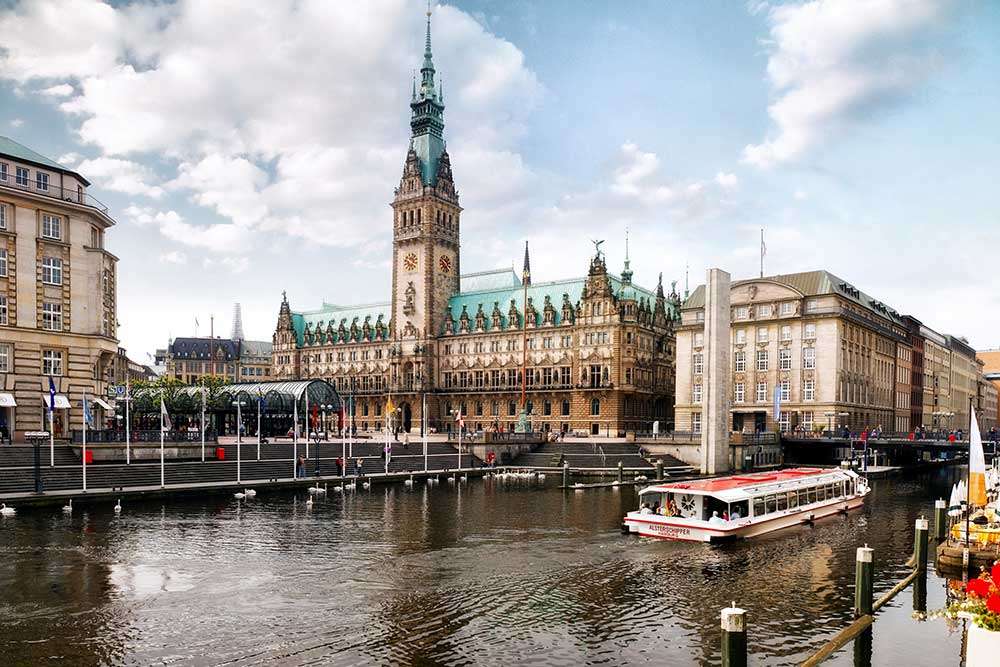
Tradition and history
Hamburg is a city with a very long tradition. A city that has earned its prosperity through trade and seafaring. Hamburg is still a hub for spices, coffee and carpets. What seems quite normal today, however, used to be special because many new smells, tastes, styles and cultures arrived in Germany first in Hamburg. Hamburg still exudes the feeling of a cosmopolitan and multicultural city that was already characteristic at that time. Due to the city’s prosperity, today’s cityscape features beautiful architecture, some of which has a French feel, as well as a traditional yet modern flair. One of the most beautiful buildings in the city center is the Hamburg City Hall. Built in the neo-Renaissance style, the building was constructed between 1886 and 1897 and has 647 rooms. For the typically rather reserved Hanseatic people, the town hall appears unusually pompous and playful. For example, 20 statues of emperors adorn the facade of the house and again point to the great tradition. Even today, the magnificent sandstone building, built on thousands of oak piles, remains untouched in its function: The Hamburg Senate and the Hamburg Parliament are seated here. If you take the actual function of the house aside, however, you get the picture of a palace in the middle of the city.
© mediaserver.hamburg.de / Jörg Modrow
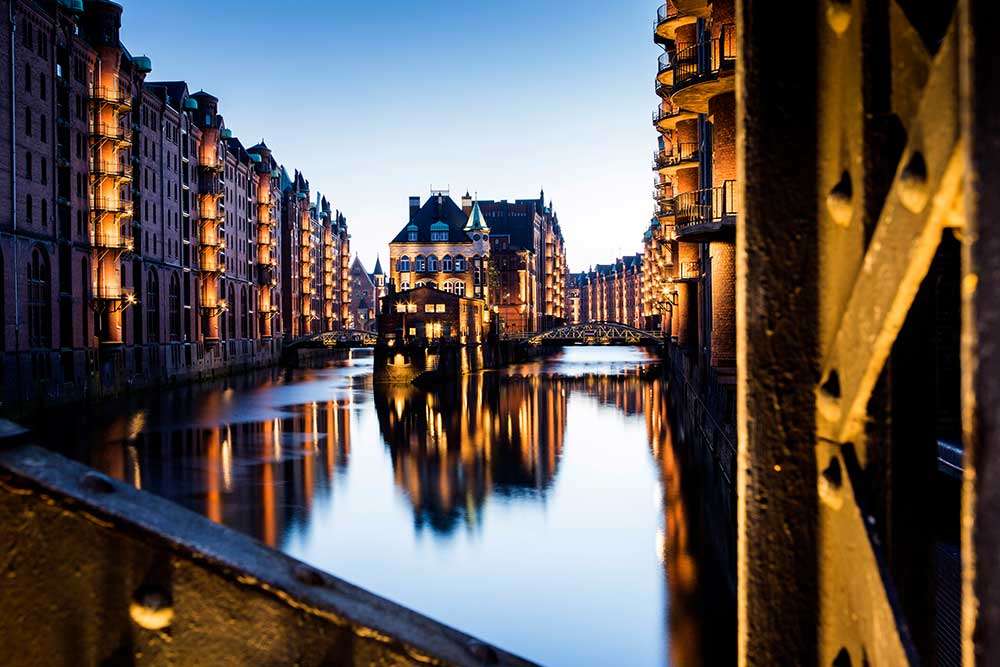
Gateway to the world
Maritime trade is a defining factor for Hamburg and the city’s history. Here, Hamburg has another treasure in its portfolio, which has also been recognized as a UNESCO World Heritage Site since July 2015: the Speicherstadt! In red brick, the building ensemble is the largest contiguous historic warehouse complex in the world. Built between 1883 and 1920, the impressively beautiful warehouses stand on thousands of oak piles in the middle of the Elbe. Numerous paths lead through the complex, which is like a separate city district and where goods have been unloaded, stored and traded for centuries. Today, there are also numerous activities and incentives that can be explored. Between coffee and warehouses for oriental carpets and spices, for example, you’ll find the Hamburg Dungeon, the Miniaturwunderland – the largest model railroad in the world and one of the most visited attractions in Europe – or the VR Headquarters, which takes people into digital worlds in the middle of the historic warehouse district.
As the “gateway to the world,” Hamburg has another special and important history: the history of emigration. Due to political and social changes in the European countries, millions of people started their new lives overseas via the port of Hamburg. Today, this history can be felt and relived in the BallinStadt Emigration Museum. In 1901, the former general director of Hapag, Albert Ballin, opened the emigrant halls on Veddel, of which three buildings have been faithfully reconstructed for the museum. In BallinStadt, the visitor experiences and learns about the global history of migration, because not only Hamburg or Europe but the whole world is the scene of migration.
A special offer of the museum is the possibility to do ancestor research. At computer terminals, visitors can not only access the unique Hamburg passenger lists with over 6 million entries – there are also 230 million German-language documents and 19 billion historical documents and images available worldwide. Researching these databases often leads to emotional moments for museum visitors when they find documents from their ancestors and they may even discover that the route taken by their grandparents or great-grandparents to the New World passed through Hamburg. For guests from overseas – especially from the USA – it is like a digital bridge to their European roots.
Beyond this great piece of history, the BallinStadt Emigration Museum can also be used for events and MICE functions. Banquet events and conferences for up to 250 people are possible in the various buildings on the approximately 2,500 m² site – summer parties can also be held on a larger scale in the outdoor area.
© Hotel Atlantic Hamburg
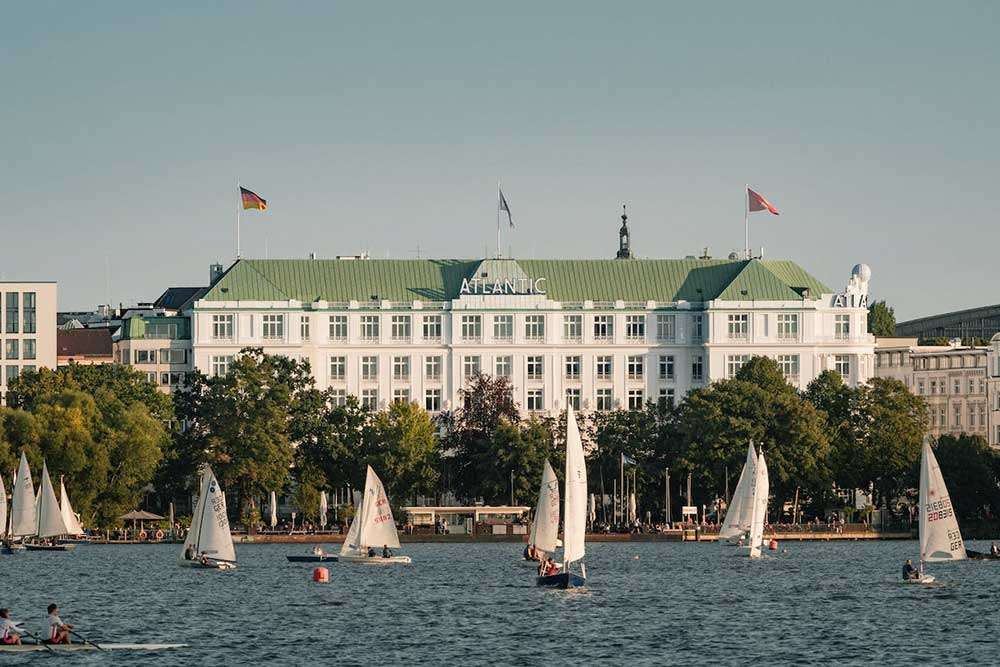
Hotels and Locations
Tradition is a facet of Hamburg, which is also reflected in the hotel industry. Numerous hotels are typical North German houses in which you can breathe the history of the city. Today we want to take a look at some hotels that stand out. With the Hotel Vier Jahreszeiten we have a top-class Grand Hotel in our ranks. For 125 years now, the hotel on the Alster has been the epitome of European grand hotels. Whoever enters the Hotel Vier Jahreszeiten can immediately sense one thing: luxury and timeless elegance. Since 1897, the hotel’s philosophy has been “service, service, service”, and this is still a top priority today. One can feel that this credo is not just said. The people who work at the Hotel Vier Jahreszeiten see their job not as a job, but as a passion. Luxury and cordiality go hand in hand here and leave the guest with a memorable experience that is second to none. Many well-known personalities have already experienced this: Among numerous other celebrities, Richard Nixon, Bill Clinton, Ingrid Bergman, Alfred Hitchcock, Morgan Freeman, Britney Spears, Gene Hackman, Jack Nicholson, the Rolling Stones and none other than a certain Walt Disney have stayed at the Hotel Vier Jahreszeiten.
Another hotel with a great tradition is the Hotel Atlantic Hamburg. Just like the Hotel Vier Jahreszeiten, located directly on the waterfront, the white building on the Alster is one of the most exclusive in the city. Year after year, the Atlantic is home to numerous balls, events and awards ceremonies. And with good reason, because the Hanseatic luxurious charm of the house provides the ideal setting for festive occasions. Many people are likely to be familiar with the house, even if they have never seen it on site in Hamburg: The iconic globe at the top of the building was the setting in the 1997 James Bond movie “Tomorrow Never Dies.” Equipped with every conceivable luxury, however, the Atlantic also makes a name for itself. 221 rooms and suites, its own movie theater, pool, sauna and fitness facilities are evidence of extremely high quality on all sides. The 5-star superior hotel has a total of 13 function rooms that can accommodate up to 1,200 guests. And the Atlantic is also a silent witness to many a famous visitors. Among others, Michael Jackson, the Shah of Persia, Charles de Gaulle and Josephine Baker stayed here.
In the heart of the Hanseatic city lies Germany’s largest owner-managed five-star hotel: the Grand Elysée Hamburg. The business and event hotel, is a lively meeting place for guests from all over the world and, thanks to its central location just around the corner from the CCH – Congress Center Hamburg, ideal for MICE guests. The airport as well as the main train station can be reached quickly and easily. In addition to 510 spacious rooms and suites, a café, three bars and four different restaurants invite you to a unique hotel experience. In addition, 30 individually designed function rooms and the largest ballroom in Hamburg with 1,400 square meters of space offer perfect conditions for any event!
Of course, Hamburg also has other exciting houses in the city. In addition to The Westin Hamburg in the Elbphilharmonie, there are several hotels from the BonVoy Marriott universe: The Renaissance Hamburg Hotel and the Hamburg Marriott Hotel in the city center, as well as the Le Méridien Hamburg on the Binnenalster. In addition, there are two Radissons in Hamburg, one in the immediate vicinity of the airport and one directly at the Dammtor train station next to the CCH – Congress Center Hamburg. We would also like to mention the Hampton by Hilton Hamburg City Centre, which is located near Hamburg’s main train station.
© Hamburg Messe und Congress / Jürgen Nerger

CCH – Congress Center Hamburg
Welcome to the cosmopolitan city of Hamburg and one of Europe’s largest and most innovative convention centers! From its architecture and location to its state-of-the-art halls and its service team – there are many good reasons to choose the new CCH – Congress Center Hamburg:
The location: Hamburg’s new jewel is located right in the heart of the trend-setting city. Hamburg ahoy! The dimensions: With nearly 400,000 square feet of usable surface area, the new CCH – Congress Center Hamburg is among Europe’s largest, most advanced convention centers. It boasts 130,000 square feet of event space and another 130,000 square feet of foyer space. Up to 12,000 visitors can meet, attend events or celebrate at the CCH simultaneously. The architecture: The modernized and remodeled CCH captivates visitors through its daylight-flooded architecture, designed to create unlimited possibilities. The breathtaking entrance hall is a must-see. Sustainability & barrier-free access: It goes without saying that the complex was planned and built with a strong focus on sustainability. And the new CCH is a barrier-free convention center. Flexibility³: The CCH features up to 50 multifunctional halls for conventions and events of any kind which can be enlarged, made smaller and arranged to suit individual needs. The venues are spread across four levels and three event sections. This means that several functions can take place simultaneously. The infrastructure: State-of-the-art AV systems are installed throughout the building, leaving no wishes unfulfilled. Getting there: The CCH – Congress Center Hamburg is conveniently located in the city center. The Dammtor mainline train station and several other stations and stops of the public transportation system are within a distance of 100 to 500 meters. The airport is likewise located close to the center. Accommodation: 8,000 hotel beds can be found within a radius of just two kilometers around the CCH. Furthermore, the impressive 27-floor Radisson Blu hotel is right next door, with direct access to the CCH – Congress Center Hamburg. The catering: The new CCH sets new standards in many respects, including cuisine. Käfer, one of the world’s leading catering and food service companies, will make sure guests are served the finest culinary delights. Enjoy your meal! The service: Count on flawless services – the experienced professional service team at the CCH – Congress Center Hamburg will make sure every request, whether big or small, will be answered by a solution that is right on target.
© mediaserver.hamburg.de / ThisIsJulia Photography
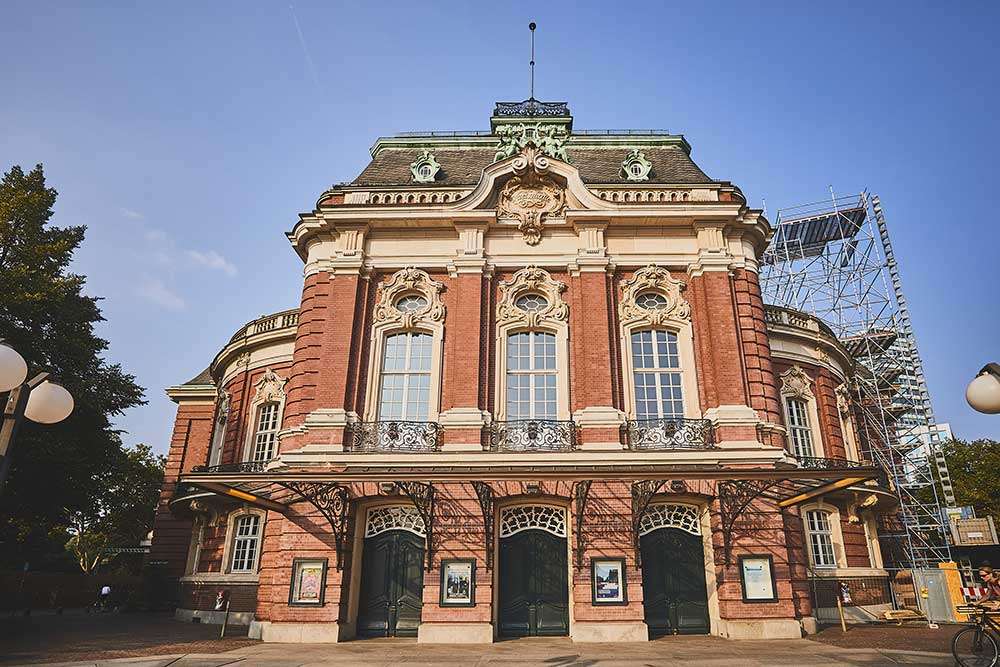
Cultural highlights
Hamburg offers a variety of places and characteristics that can only be found here. We start with the topic of high culture and introduce you to three venues where the topic of music comes first.
Of course, there is our landmark, the Elbphilharmonie Hamburg, to mention at the beginning. Almost all of the world’s major orchestras have already performed in the Great Hall. And that’s despite the fact that the concert hall, which towers unmistakably above the Elbe, only celebrated its fifth birthday in January 2022. In addition to classical and much contemporary serious music, top jazz, world music, pop and a rich music program for children can also be experienced here and in the Small Hall of the house.
At the Elbphilharmonie, the star is also the building itself. A visit to its panoramic platform, called the Plaza, offers a spectacular 360-degree view of the city and harbor. With over 15 million visitors since its opening, the Plaza is a highlight for guests from near and far, and it also ranks high in Germany’s sightseeing rankings. In uniquely successful architecture, tradition and modernity, history and the future meet in this building. The glass structure designed by Swiss architects Herzog & de Meuron, which houses a hotel and condominiums in addition to the concert halls, sits on a core-renovated brick warehouse from the 1960s, which in turn has its predecessor in the legendary “Kaiserspeicher” from the last quarter of the 19th century.
Hamburg’s second concert hall is 109 years older than the Elbphilharmonie: the tradition-rich Laeiszhalle. Built from 1904 to 1908, the house in Neustadt continues to occupy an important place in Hamburg’s musical life. Even the neo-baroque style building is a pleasure to the eyes. You can feel the history of the house just standing in front of the building. Inside, two halls with excellent acoustics await visitors.
Of special importance for the identity of the city is the Hamburg State Opera. It is the successor to the Gänsemarkt Opera, founded in 1678, which was the first theater institution in the German-speaking world to be financed not by the nobility or the clergy, but by the citizens of a city. Composers such as Georg Philipp Telemann, Georg Friedrich Händel, Gustav Mahler and Rolf Liebermann have left their mark on the house in various capacities over the centuries. The Hamburg State Opera continues to enjoy an outstanding international reputation.
© mediaserver.hamburg.de / Überquell

Hamburg - the brewery of the Hanseatic League
In the 14th century, the city of Hamburg, as one of the first members of the “Hanseatic League” of merchants, developed into the most important German transhipment and stacking point between the North Sea and the Baltic Sea. A wide variety of goods arrived in and were shipped from Hamburg. As early as the 12th century, Hamburg had a very special reputation within this trading network of various Hanseatic cities. With at times around 600 breweries, Hamburg was considered the “Brewery of the Hanseatic League”. This tradition, which at times fell into oblivion, is now flourishing again: the art of brewing. Numerous smaller and larger breweries are reviving Hamburg’s beer culture in a sustainable way, focusing mainly on honoring a wide variety of beer styles, reinventing themselves, or reviving traditional classics. The possibilities for tastings or brewery tours are almost unlimited. Whether in the “Überquell” with a view over the Elbe, in the brewery inn “Altes Mädchen” directly at the “Ratsherrenbrauerei” or in the “Landgang” in Hamburg’s Bahrenfeld district – to list all the ambitious brewers here would take too much time and space. But the fact remains: Hamburg can produce excellent craft beer!
Now that we have established this, let’s dive once again into the topic history: the Hamburg Senatsbock. In 1958, a novelty in Hamburg’s post-war history happened. Five Hamburg breweries brewed a beer together. So to speak, a co-brew of the 1950s. The “Senatsbock” was about community – about collaborative brewing, Hanseatic respect and mutual appreciation. The Senatsbock shows: In Hamburg, the “we” stands above the “I”. Over the decades, however, the Senatsbock fell into oblivion until the emerging craft beer movement in Hamburg revived this beautiful tradition. In 2015, it was brewed again together and the Senatsbock was tapped again. Since then, the tradition has been alive again, the only difference being that there are now eight breweries instead of five. Overall, the Hamburg beer scene is characterized by mutual respect. People appreciate and understand each other, and work together rather than against each other. This is also evidenced by the now annual “Hamburg Beer Week“, which celebrates Hamburg’s craft brewers and breweries. Here, too, of course, with a co-brew in which 23 Hamburg breweries from various parts of the city are involved, creating a very special Hamburg beer.
If we are on the subject of drinking, then it is not a far step to another culinary topic: eating, or rather eating out. Hamburg has numerous Guide Michelin award-winning restaurants in its ranks, but it can also score with classic cuisine. And here, too, there is a connection to the topic of beer. For example, in the “Gröninger Brauhaus“, which, in addition to its own beer, provides for the culinary well-being of its guests, from pork knuckle to fish dishes. Also on the scene with its own brewed beer is “Blockbräu” – a hanseatic beer garden, so to speak. Located directly at the harbor in the iconic Landungsbrücken, excellent German brewery cuisine is served here.
© mediaserver.hamburg.de

Sustainable approach
Hamburg is Germany’s greenest metropolis. Three-quarters of the area of the city is covered with trees. This is clearly reflected in the cityscape, and time and again guests from the USA tell us with a mixture of enthusiasm and amazement that Hamburg is probably the greenest city they have seen in Europe. We can agree with that. The numerous parks, such as the “Planten un Blomen” park in the middle of the city center or the almost 150-hectare city park, offer local recreation and quality of life in the directly in the metropolis.
But Hamburg also defines itself as a sustainable and “green” city through other facets. The city’s claim is not only evident in the hotel industry, such as the “Wälderhaus” in the Wilhelmsburg district, which in addition to the hotel business also offers the “Science Center Wald” experience exhibition as well as conference rooms and the so-called “Forum Wald”. In Hamburg, sustainability is thought in a big way. For example, you can get around almost the entire city center on rental bikes, the “Stadtrad” (city bike) – here the first half hour is free of charge – and overall the topic of “sustainable mobility concepts” is noticeable everywhere in the city. The well-timed public transport system moves hundreds of thousands of Hamburg residents and guests around the city, making a car virtually unnecessary. Those who nevertheless want to get around Hamburg on wheels also have sustainable options here, for example with the ride-sharing service MOIA. MOIA is a Volkswagen Group company and Hamburg is one of the pilot locations for this project. It’s about people with the same direction of travel sharing a cab, so to speak, and thus getting to their destination together. The whole system is smartphone app-controlled and, of course, 100% electric.
The topic of sustainable mobility was even discussed on a very large scale in 2021. The world looked to Hamburg: at the 27th ITS World Congress – the international industry platform all about intelligent mobility and networked transport. In the process, Hamburg became the venue for the mobility of tomorrow: in October 2021, experts, developers and decision-makers from almost all areas of traffic and mobility development met. To test, apply and understand. Numerous innovative projects showed where the journey is headed. Autonomous and connected driving, sustainable sharing and pooling solutions and smart logistics solutions were brought to life on test tracks and driving demo areas. In total, Hamburg counted more than 13,000 guests, around 4,000 visitors on Public Day and 400 exhibitors from all over the world on almost 40,000 m² of exhibition space.
Hamburg is a city full of exciting contrasts, with great history and long tradition! In addition, Hamburg is also a city that fulfills the claim of being a modern and green metropolis full of change and development. Have we made you a little curious? Then get in touch with us!
Let's connect!

Florian Gerdes
